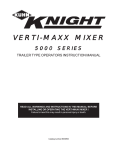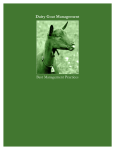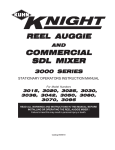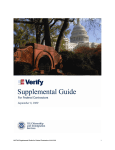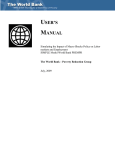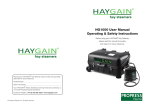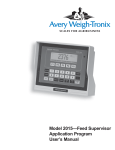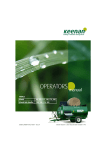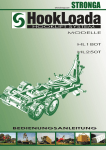Download Kuhn Rikon Corp. Mixer 5100 User's Manual
Transcript
VERTICAL MAXX MIXER 5100 SERIES Truck Type Operator’s Instruction Manual WARNING! Read manual before operating or maintaining the 5100 Series Mixer. Failure to follow instructions and safety precautions in this manual and in the safety decals could result in severe injury or death. Catalog #6270US 06/01/06 KUHN KNIGHT INC. Corporate Headquarters 1501 West Seventh Avenue Brodhead, WI 53520 Tel (608) 897-2131 Fax (608) 897-2561 www.kuhnknight.com © Copyright Kuhn Farm Machinery, Inc. Vernon, NY 13476 – USA 5100TK OPR 6270US R060106 TABLE OF CONTENTS INTRODUCTION ........................................................................ 4 Using This Manual .................................................................... 4 Model and Serial Number Information ...................................... 4 SAFETY ..................................................................................... 5 Understand Safety Words and Symbols ................................... 5 Read the Operator’s Manual .................................................... 5 Follow Safety Instructions and Precautions .............................. 5 Operating Safety Precautions ................................................... 6 Transporting Safety Precautions .............................................. 7 Safety Decals ........................................................................... 8 Safety Decal Placement ......................................................... 11 MIXER SETUP ......................................................................... 13 Safety Shields ......................................................................... 13 Lubrication .............................................................................. 13 PTO Driveline Setup and Adjustment ..................................... 13 Test Running the Mixer ........................................................... 13 MIXER OPERATION ................................................................ 14 General ................................................................................... 14 Safety ..................................................................................... 14 Limitations .............................................................................. 14 Mixing Speed .......................................................................... 14 Operation Using Mechanical Drive ......................................... 15 Step #1 - Processing ............................................................. 15 Step #2 - Mixing .................................................................... 16 Step #3 - Unloading .............................................................. 16 Step #4 - Other Mixing Recommendations ........................... 17 Operation Using Hydrostatic Drive ......................................... 17 Step #1 - Processing ............................................................. 18 Step #2 - Mixing .................................................................... 19 Step #3 - Unloading .............................................................. 20 Step #4 - Other Mixing Recommendations ........................... 20 Replacing Knives .................................................................... 21 Knife Adjustment .................................................................... 21 Removing Knives .................................................................... 21 Adding Knives ......................................................................... 21 Moving Knives - “In” or “Out” .................................................. 21 Hay Stop Adjustment .............................................................. 22 Optional Equipment ................................................................ 24 INSPECTION AND ADJUSTMENTS ....................................... 25 2 Back to Table of Contents 5100TK OPR 6270US R060106 TABLE OF CONTENTS MAINTENANCE ....................................................................... 26 Lubrication for 5144, 5156 and 5168 ...................................... 26 Lubrication for 5173, 5185 and 51100 .................................... 27 Planetary Gearbox Oil Change ............................................... 28 Miscellaneous ......................................................................... 29 Electronic Scale Indicator (optional) ..................................... 29 Oil Quality in Bull Gear Oil Bath ............................................ 29 Auger Timing ......................................................................... 29 Gears and Gearbox .............................................................. 29 Auger Scraper Bar ................................................................ 29 SPECIFICATIONS - 5144, 5156 AND 5168 ............................ 30 SPECIFICATIONS - 5173, 5185 AND 51100 .......................... 31 3 Back to Table of Contents 5100TK OPR 6270US R060106 INTRODUCTION THANK YOU for purchasing a Kuhn Knight Vertical Maxx mixer. We appreciate your business. You have purchased one of the best built, most reliable mixers available. We strive to provide you with a rugged, durable unit which is simple to maintain. If you have suggestions for any of our products, please let us know. Kuhn Knight, Inc. USING THIS MANUAL This manual should be considered a permanent part of your machine, and should remain with the machine if you sell it. If this manual is lost or becomes illegible, get a replacement by visiting www.kuhnknight.com or contacting Kuhn Knight Inc. or your dealer. This manual has been designed to help you become familiar with your unit. A separate service parts listing is available for a detailed parts breakdown of the mixer. Before you operate or maintain your unit, be sure you understand and follow all the operation, lubrication, and safety instructions on the following pages in this manual. These have been written for your safety and convenience, and to keep your unit running trouble-free for many years. MODEL AND SERIAL NUMBER INFORMATION The serial number tag is located on the front lower panel. This number must be given to service personnel for parts and service questions. ADDITIONAL AND REPLACEMENT OPERATOR’S MANUALS and safety decals may be obtained through your dealer, or by writing to the address below. Order operators manual # 6270US for 5100 Series Truck Type Mixers. Order service parts manual #6272US for model 5144, 5156 and 5168 Mixers. Order service parts manual # 6279US for models 5173, 5185 and 51100 Mixers. 4 KUHN KNIGHT INC. Corporate Headquarters 1501 West Seventh Avenue Brodhead, WI 53520 Tel (608) 897-2131 Fax (608) 897-2561 www.kuhnknight.com Back to Table of Contents 5100TK OPR 6270US R060106 SAFETY UNDERSTAND SAFETY WORDS AND SYMBOLS THIS SAFETY ALERT SYMBOL is used in this manual whenever personal safety is involved and means ATTENTION! BECOME ALERT! It stresses an attitude of “HEADS UP” for safety. Read and understand all pages in this manual that bear this safety symbol and TAKE TIME TO BE CAREFUL! The Signal Word on each label utilizes on of the following signal words defined below and the color associated with each word. DANGER: Indicates an imminently hazardous situation that, if not avoided, will result in death or serious injury. It is denoted by the word DANGER, colored in white, on a red background. WARNING: Indicates a potentially hazardous situation that, if not avoided, will result in death or serious injury, and includes hazards that are exposed when guards are removed. It may also be used to alert against unsafe practices. It is denoted by the word WARNING, colored in black, on an orange background. CAUTION: Indicates a potentially hazardous situation that, if not avoided, may result in minor or moderate injury. It may also be used to alert against unsafe practices. It is denoted by the word CAUTION, colored in black, on a yellow background. READ THE OPERATOR’S MANUAL Any person who will be operating or maintaining this mixer should first read and understand this manual and all safety warnings on the unit. This instruction manual should always be available to those responsible for the operation and maintenance of this mixer. It is the owner’s responsibility to provide this safety information to his operators and employees. Any person who does not understand the safety and operation instructions contained in this manual should not be considered qualified to operate this mixer. FOLLOW SAFETY INSTRUCTIONS AND PRECAUTIONS Specialized procedures and instructions are required and must be adhered to when working on this equipment. Failure to follow the instructions contained in this manual could result in severe personal injury, death, and/or product or property damage. All applicable safety procedures such as OSHA requirements, regional and local safety codes and requirements, safe working practices, and good judgement must be used by personnel when operating or maintaining this equipment. 5 Back to Table of Contents 5100TK OPR 6270US R060106 SAFETY OPERATING SAFETY PRECAUTIONS When the mixer is in operation it has many moving parts which could cause severe injury or death to persons coming in contact with these parts. To help avoid serious accidents, the following guidelines should always be followed. 1. BE SURE ALL SAFETY SHIELDS are in place before operating, including any truck and driveline shields. Exposed machinery due to missing shields can grab hands and clothing and cause severe injury or death. Repair or replace any damaged or missing shielding. 2. NEVER PUT ARMS OR FEET INSIDE unit, power chute, conveyor or discharge door opening, nor climb on or in the mixer while it is running. NEVER allow anyone to position themselves over or near the top of the mixer while it is running. Rotating augers, and sprockets can grab clothing or create pinch points which can cause severe injury or death to the operator or bystanders. Before inspecting, servicing, repairing, or cleaning the mixer, disengage the PTO, stop the trucks engine and remove the truck’s ignition key so that the mixer can not be accidentally turned on. 3. NEVER HAND FEED MATERIALS into mixer while it is running. Rotating augers inside the mixer may not be visible from the loading point, and may cut or grab hands, clothing, or material being loaded, causing severe injury. Always turn off the mixer and stop the truck’s engine before hand loading materials. 4. NEVER ATTEMPT TO RELEASE JAMMED MATERIALS OR CLEAN MATERIALS from any area of the mixer or discharge chute without disengaging the PTO and stopping the truck’s engine and remove the ignition key first. Moving parts can be hidden by materials, and stopped parts can start unexpectedly, causing severe injury or death to operators or bystanders. 5. DO NOT ALLOW OPERATION of this unit by inexperienced or unqualified people. Keep all bystanders a safe distance away from the mixer during operation. Operators of this unit must be alert and use good judgement at all times. The Operator should not climb on the ladder or any part of the mixer when loading, mixing or discharging material. 6. DO NOT wear loose or floppy clothing, jewelry or long hair while operating this unit. It may become entangled in moving machinery. 7. BE SURE the inside of the mixer is clear of any obstructions before operating. 8. SHOULD A PROBLEM OCCUR during operation of mixer, always disengage the PTO, stop the truck’s engine and remove the truck’s ignition key before investigating the problem. If the power source to the mixer has not been disconnected, the mixer may start unexpectedly, causing severe injury or death. 9. USE CAUTION WHEN WORKING AROUND THE DISCHARGE AREA. Stay clear of power chute, conveyor & slide tray. These are controlled from the truck’s cab and could operate without warning, creating pinch points which could cause severe injury or death. Always disengage the PTO, stop the truck’s engine and remove the truck’s ignition key before working close to the discharge area. 6 Back to Table of Contents 5100TK OPR 6270US R060106 SAFETY TRANSPORTING SAFETY PRECAUTIONS WHEN TRANSPORTING A LOADED MIXER, FOLLOW THESE SAFETY PRECAUTIONS. FAILURE TO DO SO COULD RESULT IN A LOSS OF CONTROL AND SEVERE INJURY OR DEATH. • Do not allow anyone to ride on or in the mixer. • Reduce speed when traveling loaded and/or over rough, soft, or wet terrain. Exercise caution on side slopes and when turning corners. • When working on slopes or inclines, travel uphill or downhill. Keep the truck transmission in gear when going downhill. • Avoid driving on loose fill, rocks, inclines, ditches, and holes. • Always park the mixer on level ground and block the truck’s tires. • If mixer is for highway transit the end user is responsible for federal, state and local vehicle safety regulation compliance (example: under-ride requirements, lighting and weight limitations). • When transporting the mixer, always keep the power discharge chute or slide tray in the upright (retracted) position. For long transport distances the power chute must be locked in place using the chains provided. LOCK CHUTE AS SHOWN 7 Back to Table of Contents 5100TK OPR 6270US R060106 SAFETY SAFETY DECALS Safety decals are placed on this unit for the protection of the operator or any person working on or standing nearby the unit. Everyone who operates or maintains the mixer must first read this manual and understand the meaning of all safety labels. Contact your dealer if foreign language decals are required. Keep safety decals clean and legible. If any are missing or illegible, contact your Kuhn Knight dealer or Kuhn Knight to obtain replacements. The part numbers for the decals are located in the lower right hand corner of the decal, and listed in this manual on the following pages. Replacement decals may be ordered through your dealer or the address below. Kuhn Knight, Inc. 1501 West 7th Ave., Brodhead, WI 53520 701 Cherry Ave., Greeley, CO 80632 Complete sets of decals (including information decals) can be ordered by using the following part numbers: UNIT PART NO. 5144 ....... 176-668 5156 ....... 176-669 5168 ....... 176-670 5173 ....... 176-671 5185 ....... 176-672 51100 ..... 176-673 When replacing decals, be sure the surface area is clean and dry, peel the backing off the decal, and apply to the mixer. Be sure to wipe with a clean cloth to rub out all air bubbles to assure a good seal. For best adhesion decals should be applied in temperatures of 50°F / 10°C or warmer. 8 Back to Table of Contents 5100TK OPR 6270US R060106 SAFETY SAFETY DECALS Immediately replace all worn or damaged Safety Decals (listed on these pages). Please supply the unit’s serial number with the order. Figure 1 WARNING, To prevent serious injury from power driven parts...... Part Number 170-849 Figure 2 DANGER, Rotating auger hazard...... Part Number 171-820 Figure 3 WARNING, To prevent serious injury or death...... Part Number 171-913 Figure 4 WARNING, To prevent serious injury or death...... Part Number 171-911 9 Back to Table of Contents 5100TK OPR 6270US R060106 SAFETY SAFETY DECALS Immediately replace all worn or damaged Safety Decals (listed on these pages). Please supply the unit’s serial number with the order. Figure 5 DANGER, Rotating auger hazard...... Part Number 171-947 Figure 6 WARNING, Lifting hazard...... Part Number 172-820 Figure 7 RED REFLECTOR Part Number 174-686 10 Back to Table of Contents 5100TK OPR 6270US R060106 SAFETY SAFETY DECAL PLACEMENT MODELS 5144, 5156, 5168, 5173, 5185 AND 51100 Illustration shows all door configurations for decal placement. Certain door combination may not be available on all machines. 2 5 4 1 6 3 1 11 Back to Table of Contents 5100TK OPR 6270US R060106 SAFETY SAFETY DECAL PLACEMENT MODELS 5144, 5156, 5168, 5173, 5185 AND 51100 Illustration shows all door configurations for decal placement. Certain door combination may not be available on all machines. 2 5 1 7 1 12 Back to Table of Contents 5100TK OPR 6270US R060106 MIXER SETUP READ AND FOLLOW THESE INSTRUCTIONS WHEN SETTING UP THE MACHINE. To avoid personal injury: The hopper floor may be slippery and the augers can spin unexpectedly when stepped on. Use caution when stepping or standing inside the unit and put a protective cover over the auger knives. SAFETY SHIELDS Be sure all safety shields are in place and functioning properly. Replace all damaged or missing shields immediately. See parts manual for replacement safety shield part numbers. LUBRICATION Check to be sure that all gear cases and oil bath enclosures contain oil, and that bearings and joints have been greased. (See maintenance section) PTO DRIVELINE SETUP AND ADJUSTMENT FOR MODEL 5144 The driveline connecting the two 2:1 gearboxes has a shearbolt protection device to protect the machine in an overload situation. If the driveline spins freely, the shear bolt has broken and needs to be replaced. Replace the broken shear bolt with a new 1/4” x 2” grade 5 bolt. Always replace the shear bolt with the same size and grade as the original for proper operation. FOR MODELS 5173, 5185 AND 51100 The final driveline before the planetary gearbox has a torque disconnect device to protect the machine in an overload situation. The torque disconnect type of driveline protection is an automatic, no maintenance form of protection when compared to shear bolt or friction type clutches. It uses pawls spring loaded into a ratchet to transmit torque. When the torque overcomes the spring force the pawls pull away from the rachet preventing driveline damage. To reset, simply throttle the truck down and the pawls will reengage. If an obstruction must be removed to get it to reengage, always shut the truck off and remove the key from the truck’s ignition before removing the obstruction. NOTE: Torque the lock bolt of the truck driveline to 75ft. lbs. (17mm 6pt socket suggested). TEST RUNNING THE MIXER 1. Check for proper assembly, adjustment, and lubrication. Check to see that there is adequate oil in the gearboxes and/or bull gear oil bath. If unit is equipped with a discharge chute, oil the roller chains and check to be sure all bolts and set screws are tight. Review Operating Safety Precautions and Lubrication Instructions before operating the mixer. 2. Be sure all shields are properly in place. 3. Check for and remove any foreign objects in the mixer hopper and discharge opening. 4. Check to see that the door is closed. 5. Be sure no one is inside the mixer. 6. Test run the mixer. a. Make sure mixer is empty, then start the mixer. b. Run mixer for at least five minutes at 3/4 of rated PTO RPM. c. Raise and lower the door and the chute or slide tray several times. d. Disengage the mixer, turn off the truck engine, and remove the key from the ignition. e. Check the mixer drive components to be sure they are not abnormally hot. If any of these items are not running as indicated, immediately repair or contact your local dealer. Always refer to Operating Safety Precautions before operating or servicing the mixer. 13 Back to Table of Contents 5100TK OPR 6270US R060106 MIXER OPERATION Always refer to Operating Safety Precautions and Safety Decal sections of this manual before operating this mixer. GENERAL The Kuhn Knight Vertical Maxx Mixer is designed for blending dairy and beef rations. Most commonly used ingredients can be mixed quickly and uniformly in this mixer. If you have questions regarding your feed ration or have other applications, please contact Kuhn Knight Inc. The Vertical Maxx Mixer’s performance can vary greatly according to the difference in material, loading sequence, mixing speed and unloading methods. The following guidelines should be understood before operating the mixer. SAFETY When the mixer is in operation it has many moving parts which could cause severe injury or death to persons coming in contact with these parts. To help avoid serious accidents, please read and understand the “Operating Safety Precautions” located in the front of this manual. LIMITATIONS Keep in mind the overall size of the mixer to allow clearance through doorways. Be sure that there is enough clearance to compensate for the position of the discharge chute or conveyor. Do not force hay into augers with loader or any other device. The area over the augers does not have bucket guards, avoid bucket contact with the augers to prevent potential damage to knives and auger. MIXING SPEED When deciding when and how fast to operate the mixer, factors such as ingredients being used, the thoroughness of the mix, and the time available to mix must be considered. Normal mixing speed is 3/4 to full PTO speed. Do not exceed rated PTO speed. When the mixer is operated faster than rated PTO speed the strain on the drive train and mixer is greatly increased. 14 Back to Table of Contents 5100TK OPR 6270US R060106 MIXER OPERATION Always refer to Operating Safety Precautions and Safety Decal sections of this manual before operating this mixer. OPERATION USING MECHANICAL DRIVE There are some basic concepts that must be understood to achieve top mixing performance with the VerticalMaxx. A new machine will need an initial run-in period to polish the augers and mixer sides to achieve correct material movement inside the mixer. Until the unit is polished inside, one may experience material spillage, dead spots, or increased horsepower requirements. The load size may need to be reduced until the unit is polished inside. Mixing a ration in a vertical mixer generally involves three steps; processing, mixing, and unloading. The sequence and timing of these steps is very important, and is different for every operator because of variations in materials and conditions. There is some experimentation that must be done to work out the best equipment, sequence, and timing for your particular operation. Following are some general suggestions to achieve good results. STEP #1 - PROCESSING MATERIALS Some feed materials will first need to be processed alone in the Vertical-Maxx before they can be efficiently mixed with other feedstuffs in the Vertical-Maxx mixer. These materials include; A. Large square or round bales of alfalfa* B. Large square or round bales of high moisture “Baleage”* C. Large square or round bales of long mixed grasses, wheat or oat hay and crop residue bales (straw or soybean stubble)* D. Very light and bulky feedstuffs* * Always remove twine from bales before loading into the mixer. MIXER SETUP A. Be sure that mixer is sitting level front to back and side to side. This will ensure a level and even mix of feed. B. Completely close mixer door. C. Set Hay Stops according to instructions in setup section. LOADING A. With the truck running at approximately 3/4 of rated PTO speed, load baled hay into center of mixer. B. Allow mixer enough time to process bale before adding other ingredients (4 to 10 minutes) If you need to inspect progress of the processing /mixing, always shut off the truck and remove the ignition key before climbing the ladder to inspect the load. C. Processing of long stem forages will continue as other materials are added and mixed. Be careful not to over process these materials before adding other ingredients. ADJUSTMENTS A. When processing materials, there may be spillage over the side of the mixer. Following are some steps to reduce this; 1. Reduce load size 2. Reduce RPM 3. Be sure mixer is level 4. Be sure augers and hoppers are polished so feed moves well inside mixer. 5. Back off “Hay Stops” to a less aggressive or neutral position. 6. Reset knives to a less aggressive setting. 7. If spillage still occurs, the optional side extensions for the mixer may be needed. 15 Back to Table of Contents 5100TK OPR 6270US R060106 MIXER OPERATION Always refer to Operating Safety Precautions and Safety Decal sections of this manual before operating this mixer. STEP #2 - MIXING MATERIALS The Vertical-Maxx is designed to mix a wide variety of feedstuffs efficiently and quickly. After the long stem forages are coarsely cut in the processing step, other materials such as silage, grains, haylage, and commodities can be added and mixed. LOADING SEQUENCE With mixer running at approximately 3/4 of rated PTO RPM, and the long stem material processed to a desirable length, the loading of remaining ingredients can begin. The sequence of loading materials will depend on the loading methods and their location relative to the mixer, but a typical loading sequence would be; 1. Load and process all long stem hay first 2. Load wet and dry commodities, etc.. 3. Load minerals, proteins, and other small quantity ingredients 4. Load haylage and corn silage 5. Load all liquid fats, water, and other liquids. Always load liquids at the center of the mixing chamber. Note: Never load long stem bales last. They will not be processed or mixed into the ration, and may cause unloading or spillage difficulties. Processing of long stem forages will continue as other materials are added and mixed. Be careful not to over process these materials before adding other ingredients. Load all ingredients as quickly as possible, and allow a final mix time of 3 to 7 minutes, or whenever the load looks consistently mixed. ADJUSTMENTS A few loads will need to be tried to establish the best loading sequence, PTO RPM, mix time, and hay stop position for your particular situation. Adjustments may need to be made if you see the following; 1. Spillage - refer to the adjustments listed in the processing steps. 2. High horsepower a. Reduce load size b. Be sure mixer sides and augers are “polished” to insure correct feed movement inside mixer. c. Back off “Hay Stops” to a less aggressive or neutral position see Hay Stop Adjustment section d. Modify the knife setting quantity or placement, see Inspection and Adjustment section e. Add optional short knives if available 3. Forage is cut too short a. Reduce the initial processing time b. Reduce the aggressiveness of the hay stops, see Hay Stop Adjustment section c. Reduce the total loading time d. Reduce the mixer RPM to limit aggressiveness in processing e. Modify the knife quantity or placement, see Knife Adjustment section STEP #3 - UNLOADING Try to unload the mixed ration within a short time after mixing. A fully loaded mixer which is bounced over rough terrain or allowed to settle will require more horsepower during start-up. 1. Lower slide tray. 2. Start the mixer and partially open the door. 3. Adjust the door height for the desired flow of feed, while moving forward along the discharge path. 4. After load begins to discharge, increase truck RPM to full PTO to insure fast and thorough clean out. 16 Back to Table of Contents 5100TK OPR 6270US R060106 MIXER OPERATION Always refer to Operating Safety Precautions and Safety Decal sections of this manual before operating this mixer. STEP #4 - OTHER MIXING RECOMMENDATIONS Run truck at approximately 3/4 of rated truck RPM while processing to help reduce HP and/or spillage of hay. Set hay stops to #4 or #5 low positions (see Hay Stop Adjustment). This will reduce spillage due to hay “piling” up near the hay stops. A. If HP required to process and mix high percent amounts of balage/grassy hay is too high, the following can be done: 1. The remaining knives can be “laid-back” to a less aggressive “in” position. (see Knife Adjustment section below) 2. Remove the optional extra knives. 3. Add optional short knives if available in lieu of the long knives to help reduce HP B. If spillage in balage or grassy material is excessive: 1. Move Hay Stops to the “neutral” positions. 2. Lower PTO RPM while processing. 3. Move knives into the “laid-back” or “in” positions. 4. Remove optional extra knives from augers If HP requirement is still high. Starting from the top of auger, leave knife at very top of auger and remove knives below it, as required. 5. Add optional side extensions. OPERATION USING HYDROSTATIC DRIVE There are some basic concepts that must be understood to achieve top mixing performance with the VerticalMaxx. A new machine will need an initial run-in period to polish the augers and mixer sides to achieve correct material movement inside the mixer. Until the unit is polished inside, one may experience material spillage, dead spots, or increased horsepower requirements. For the first week or two, keep the load sizes down under 30,000 lbs. to allow the hydro to “break in.” This will help prevent stalling the hydro upon start-up. If the outside temperature is below freezing, the hydrostatic oil should be circulated under no load conditions for at least 10 minutes. Run the mixer with the augers at half rpm (truck engine @ 1300 rpm) to help warm up the oil. Mixing a ration in a vertical mixer generally involves three steps; processing, mixing, and unloading. The sequence and timing of these steps is very important, and is different for every operator because of variations in materials and conditions. There is some experimentation that must be done to work out the best equipment, sequence, and timing for your particular operation. Following are some general suggestions to achieve good results. 17 Back to Table of Contents 5100TK OPR 6270US R060106 MIXER OPERATION Always refer to Operating Safety Precautions and Safety Decal sections of this manual before operating this mixer. STEP #1 - PROCESSING MATERIALS The hydrostatic drive is sized to accommodate most beef and dairy rations. Situations that my “overload” the hydro and cause it to stall are: A. A mixer that is overloaded beyond recommended mixing capacity B. Trying to start a loaded machine with cold system oil C. Loading the mixer, shutting it off, and driving long distances may make it hard to start. D. Mixing the following: Industrial material such as compost, dirt, sludge, and other heavy non-ag materials. Rations with large quantities of molasses and other sticky feeds. Call the factory if the ration to be mixed or the mixing situation is of a questionable type Some feed materials will first need to be processed alone in the Vertical-Maxx before they can be efficiently mixed with other feedstuffs in the Vertical-Maxx mixer. These materials include; A. Large square or round bales of alfalfa* B. Large square or round bales of high moisture “Baleage”* C. Large square or round bales of long mixed grasses, wheat or oat hay and crop residue bales (straw or soybean stubble)* D. Very light and bulky feedstuffs* * Always remove twine from bales before loading into the mixer. MIXER SETUP A. Be sure that mixer is sitting level front to back and side to side. This will ensure a level and even mix of feed. B. Completely close mixer door. C. Set Hay Stops according to instructions in setup section. LOADING A. With the truck running at approximately 3/4 of rated PTO speed, load baled hay into center of mixer. B. Allow mixer enough time to process bale before adding other ingredients (4 to 10 minutes) If you need to inspect progress of the processing /mixing, always shut off the truck and remove the ignition key before climbing the ladder to inspect the load. C. Processing of long stem forages will continue as other materials are added and mixed. Be careful not to over process these materials before adding other ingredients. ADJUSTMENTS A. When processing materials, there may be spillage over the side of the mixer. Following are some steps to reduce this; 1. Reduce load size 2. Reduce RPM 3. Be sure mixer is level 4. Be sure augers and hoppers are polished so feed moves well inside mixer. 5. Back off “Hay Stops” to a less aggressive or neutral position. 6. Reset knives to a less aggressive setting. 7. If spillage still occurs, the optional side extensions for the mixer may be needed. 18 Back to Table of Contents 5100TK OPR 6270US R060106 MIXER OPERATION Always refer to Operating Safety Precautions and Safety Decal sections of this manual before operating this mixer. STEP #2 - MIXING MATERIALS The Vertical-Maxx is designed to mix a wide variety of feedstuffs efficiently and quickly. After the long stem forages are coarsely cut in the processing step, other materials such as silage, grains, haylage, and commodities can be added and mixed. The operating speed of the truck engine while mixing can be preset by setting either the mechanical throttle linkage or by using the electronic cruise control button- (turn on cruise control, hold the “accel” button and take the truck rpm’s up to the desired speed). The hydro is set so that mixer maximum operating speed is at 2100 truck engine rpm (hydro lever full open-full stroke), and the truck should be at least running at 1600 rpm to start the mixer efficiently, (with hydro lever at least 1/2 way forward). On larger loads, it is better to engage the hydro lever slowly vs. a quick engage of the lever. Mixing speed can be set anywhere between the 1600 and 2100 engine rpm range. If the truck is running at an idle, the hydro motor may not start. LOADING SEQUENCE With mixer running at approximately 3/4-full rated PTO RPM, and the long stem material processed to a desirable length, the loading of remaining ingredients can begin. The sequence of loading materials will depend on the loading methods and their location relative to the mixer, but a typical loading sequence would be; 1. Load and process all long stem hay first 2. Load wet and dry commodities, etc.. 3. Load minerals, proteins, and other small quantity ingredients 4. Load haylage and corn silage 5. Load all liquid fats, water, and other liquids. Always load liquids at the center of the mixing chamber. Note: Never load long stem bales last. They will not be processed or mixed into the ration, and may cause unloading or spillage difficulties. Processing of long stem forages will continue as other materials are added and mixed. Be careful not to over process these materials before adding other ingredients. Load all ingredients as quickly as possible, and allow a final mix time of 3 to 7 minutes, or whenever the load looks consistently mixed. ADJUSTMENTS A few loads will need to be tried to establish the best loading sequence, PTO RPM, mix time, and hay stop position for your particular situation. Adjustments may need to be made if you see the following; 1. Spillage - refer to the adjustments listed in the processing steps. 2. High horsepower a. Reduce load size b. Be sure mixer sides and augers are “polished” to insure correct feed movement inside mixer. c. Adjust the “Hay Stops” to a less aggressive position. See Hay Stop Adjustment section. d. Modify the knife setting quantity or placement. See Inspection and Adjustment section. e. Add optional short knives if available 3. Forage is cut too short a. Reduce the initial processing time b. Reduce the aggressiveness of the hay stops. See Hay Stop Adjustment section. c. Reduce the total loading time d. Reduce the mixer RPM to limit aggressiveness in processing e. Modify the knife quantity or placement. See Knife Adjustment section. 19 Back to Table of Contents 5100TK OPR 6270US R060106 MIXER OPERATION Always refer to Operating Safety Precautions and Safety Decal sections of this manual before operating this mixer. STEP #3 - UNLOADING Try to unload the mixed ration within a short time after mixing. A fully loaded mixer which is bounced over rough terrain or allowed to settle will require more horsepower during start-up. 1. Lower slide tray or lower and start the discharge chute. 2. Start the mixer and partially open the door. The mixer should operate with the hydrostatic system operating in the “green” range on the pressure gauge during mixing and unloading. Pressures may spike above the green into the yellow range for short durations (2-4 seconds) during mixing. The system should never spike into the red zone during mixing. A short spike a few seconds in the red zone during start-up of heavy rations would be acceptable. Longer durations of run time in the yellow or red zones would be considered an overload of the hydro drive. The load size for a given ration should be reduced if an overload condition is experienced. 3. Adjust the door height for the desired flow of feed, while moving forward along the discharge path. 4. After load begins to discharge, increase truck RPM to full PTO to insure fast and thorough clean out. 5. Final clean out of the mixer while unloading can be obtained by over speeding the augers and “blowing” the feed sitting on them off, as needed. This is achieved by running the truck engine above normal engine speed to full governed speed (and hydro control full-open) for a few seconds. 6. If truck is equipped with 2 speed hydro option, “high” range can be used to speed up unload time and improve clean out. It can be shifted to “high range” with approximately 10,000 lbs. or less in the mixer. STEP #4 - OTHER MIXING RECOMMENDATIONS Run truck at approximately 3/4 of rated truck RPM while processing to help reduce HP and/or spillage of hay. Set hay stops to #4 or #5 low positions (see Hay Stop Adjustment). This will reduce spillage due to hay “piling” up near the hay stops. A. If HP required to process and mix high percent amounts of balage/grassy hay is too high, the following can be done: 1. The remaining knives can be “laid-back” to a less aggressive “in” position. (See Knife Adjustment section below) 2. Remove the optional extra knives. 3. Add optional short knives if available in lieu of the long knives to help reduce HP B. If spillage in balage or grassy material is excessive: 1. Move Hay Stops to the “neutral” positions. 2. Lower PTO RPM while processing. 3. Move knives into the “laid-back” or “in” positions. 4. Remove optional extra knives from augers If HP requirement is still high. Starting from the top of auger, leave knife at very top of auger and remove knives below it. 5. Add optional side extensions. C. Small knives can be removed if final cut-length of material is too short and fine, but long knives may need to be left intact for initial processing of materials. 20 Back to Table of Contents 5100TK OPR 6270US R060106 MIXER OPERATION Always refer to Operating Safety Precautions and Safety Decal sections of this manual before operating this mixer. KNIFE ADJUSTMENT The Vertical Maxx Mixer is designed and intended for processing and mixing rations that include long stem forages. In most cases, the knives that come standard on the mixer are placed to work well in most rations. However, some rations may require adding or removing knives to obtain the desired result. REMOVING KNIVES Individual knives may be removed from the auger if the ration does not include hay, or includes very small amounts of small square bale hay or tub ground hay. Removing knives will decrease the aggressive cutting action on the stem length of the ration and may also reduce horse power requirements. ADDING KNIVES If the hay in your ration is not being processed enough or fast enough, extra knives and backers may be ordered through your dealer. Adding extra knives will help break down and process materials faster, but may increase the horsepower required to process and mix. The placement of knives towards the bottom of the auger will process the forage faster and make stem the length shorter, but may require more horsepower. Placement of knives higher on the auger will assist in breaking up bales faster after initial loading. MOVING KNIVES - “IN” OR “OUT” “Out” Position The “out” position on the knives (hole 1 & 3) will tend to move the long stem hay and lighter bulky materials best in the early stages of processing and mixing. This setting may result in more feed “boiling” inside the mixer and may increase feed spillage in certain materials. Knives placed in the out positions are very aggressive in processing feed it will also increase the HP requirement. “In” Position The “in” position on the knives (hole 1 & 2) will slow down the early feed movement of long stem hay and lighter bulky materials, resulting in less spillage due to clearance between the knives. This setting is more desirable for heavy rations with long run time and where over processing can occur. Knives placed in the “in” position are less aggressive in processing feed and will also reduce the HP requirement. 3 OUT POSITION 1 IN POSITION 2 1 REPLACING KNIVES When knives become worn and rounded on the leading edge, their efficiency is greatly reduced, resulting in longer processing times and increased HP requirements. Refer to your service parts manual and contact your Kuhn Knight Dealer for replacement part ordering. 21 Back to Table of Contents 5100TK OPR 6270US R060106 MIXER OPERATION Always refer to Operating Safety Precautions and Safety Decal sections of this manual before operating this mixer. HAY STOP ADJUSTMENT Do not adjust the Hay Stops while the mixer is running. Moving feed inside the mixer can make the Hay Stop move suddenly causing injury to the person making the adjustment. Never operate the mixer without the Hay Stop Lock Bolt installed. The Hay Stop Lock Bolt prevents the hay stop from rotating past the intended range of operation. If the hay stop bolt and the positioning pin are removed, the hay stop may protrude into the mixer contacting the moving auger causing damage to the hay stop and the auger. Lock Bolt Lock Nut 22 Back to Table of Contents 5100TK OPR 6270US R060106 MIXER OPERATION Always refer to Operating Safety Precautions and Safety Decal sections of this manual before operating this mixer. Do not adjust the Hay Stops while the mixer is running. Moving feed inside the mixer can make the Hay Stop move suddenly causing injury to the person adjusting it. HAY STOP ADJUSTMENT The mixer is equipped with two adjustable “Hay Stops”, one located at the right front and the other at the left rear of the mixer. The purpose of the “Hay Stops” is to provide better control of the processing and mixing of long stem forages into the ration. There are a total of 5 positions for the hay stops, and by doing some experimenting with the settings, you will be able to determine the proper settings for your ration. The most common setting for normal forage rations that include some alfalfa hay is the #2 high position (see figure above). High Positions The high positions on the hay stops (#1 & #2) will tend to slow the movement of the long stem hay and lighter, bulkier materials early in the processing and mixing sequence. This allows the auger/knives to “cut” the hay more aggressively. The feed flow will be slowed down, when the #1 setting is used, and may result in more feed “boiling” inside the mixer, and may increase feed spillage in certain materials. When using very light, bulky materials like dry grasses, the #1 setting is recommended. When processing and mixing most alfalfa bales and other forages, the #2 setting is recommended. If the ration forage length becomes too short, then move one or both stops to the #3 neutral setting. Low Position The low positions (#4 & #5) will give a more aggressive cutting action later in the load sequence. Because the low position hay stops are located closer to the bottom knives and auger flighting, they interact more aggressively with feed that moves through the lower half of the auger. These positions are more desirable if heavier rations are mixed, or if fine, short stem lengths are required. These low positions could also be used in breaking up frozen chunks of feed, getting a fine cut on hay already torn apart when loaded, or to aid breakup of feed byproducts. Note: The low positions (#4 & #5) generally increase the horsepower requirements, and should be used with care for most high forage/hay rations that use dry bulky forages, or that need to maintain a longer stem length. Neutral Position If your ration does not include significant amounts of long stem hay, or if you experience significant hay “boiling“ and spillage, then the hay stops can be set in a neutral position. This allows the feed to travel more freely end to end, and reduces the amount of stem length reduction while mixing. 23 Back to Table of Contents 5100TK OPR 6270US R060106 MIXER OPERATION Always refer to Operating Safety Precautions and Safety Decal sections of this manual before operating this mixer. OPTIONAL EQUIPMENT ELECTRONIC SCALES Kuhn Knight Inc. offers a range of scale heads with the most popular features to display accurate ration weight while loading. Refer to the scale manufactures operator manual for operation and maintenance. EXTRA KNIVES Extra short and long knives are available for certain models. See Mixer Operation section for more information. CARBIDE KNIVES Carbide knives are used in conditions where normal knife wear is decreased by the materials being mixed. PROGRESSIVE KNIVES Progressive knives are longer and are more aggressive than standard or carbide knives. Progressive knives will decrease mixing and hay processing time but will increase horsepower requirements to drive the mixer. SIDE EXTENSIONS 8” Side Extensions are available to minimize spillage of light materials during processing and mixing. The purpose of the side extension option is to help contain long stem material while processing, with the convenience of loading from either side. HAY RESTRAINT The optional steel tube on the upper perimeter of the tub assures that large round bales will stay inside the mixing chamber while processing while allowing little to no hay loss. STAINLESS STEEL LINERS Stainless Steel Liners are installed when mixing course materials to extend mixing chamber life span. SINGLE SPEED HYDRAULIC DRIVE Hydrostatic drive replaces the mechanical drive system, eliminating the driveline and reduction gearbox from the truck PTO. VARIABLE TWO SPEED HYDRAULIC DRIVE Two speed hydrostatic drives offer greater start-up torque and speeds up final clean-out compared to single speed hydrostatic drive. 24 Back to Table of Contents 5100TK OPR 6270US R060106 INSPECTION AND ADJUSTMENTS Always stop mixer, shut off the truck’s engine and remove the ignition key before servicing, repairing or cleaning the machine. If work must be done inside the mixer, put a protective cover over the auger knives to avoid injury. The hopper floor and fighting may be slippery. Use caution when stepping on or standing inside the machine. Use safe shop procedures and exercise caution when working on the mixer! INSPECTION & ADJUSTMENTS Safety Decals for readability. If any safety decals are removed, obstructed, or otherwise not understandable, they should be replaced immediately. Keep all decals clean - see Safety Decal section for more information. Safety Shielding to be sure all shielding is in place and functioning properly. Replace all damaged or missing shielding immediately - see parts pages for more information. Bolts and Set Screws after a few hours of use and each month thereafter. Tighten if necessary. Auger Knives should be replaced when the long stem material is no longer sufficiently broke up, and there is a noticeable increase in HP requirement. Inspect knife fasteners to be sure they are tight. IMPORTANT: WHEN WELDING ON THIS UNIT: Do Not allow the current to flow through the bearings, roller chains, or scale weigh bars. Ground directly to the item being welded. ALWAYS disconnect weigh bar cords from scale indicator before welding. Rain can accumulate in mixer if stored outside, always leave the door partially open to allow unit to drain. In freezing weather, snow can accumulate in mixer if stored outside, always leave the door partially open to allow unit to drain melted snow and check hopper for snow or ice buildup before operating unit. Remove any ice build up before use. 25 Back to Table of Contents 5100TK OPR 6270US R060106 MAINTENANCE Always stop mixer, shut off the truck’s engine and remove the ignition key before servicing, repairing or cleaning the machine. If work must be done inside the mixer, put a protective cover over the auger knives to avoid injury. The hopper floor and fighting may be slippery. Use caution when stepping on or standing inside the machine. Use safe shop procedures and exercise caution when working on the mixer! LUBRICATION FOR 5144, 5156 AND 5168 It is extremely important that the following lubrication guide be followed: For lubricating bearings, use a good quality multipurpose grease. Replace all damaged or missing grease zerks immediately. Always clean zerks before using grease gun. Pump the grease in slowly until a slight bead forms around the bearing seals. Once a month check lines and connections on grease banks for leaks. 26 Back to Table of Contents 5100TK OPR 6270US R060106 MAINTENANCE Always stop mixer, shut off the truck’s engine and remove the ignition key before servicing, repairing or cleaning the machine. If work must be done inside the mixer, put a protective cover over the auger knives to avoid injury. The hopper floor and fighting may be slippery. Use caution when stepping on or standing inside the machine. Use safe shop procedures and exercise caution when working on the mixer! LUBRICATION FOR 5173, 5185 AND 51100 It is extremely important that the following lubrication guide be followed: For lubricating bearings, use a good quality multipurpose grease. Replace all damaged or missing grease zerks immediately. Always clean zerks before using grease gun. Pump the grease in slowly until a slight bead forms around the bearing seals. Once a month check lines and connections on grease banks for leaks. The gear drive enclosure is designed to be used as an oil bath. With the unit level, fill oil bath through dipstick until the oil level reaches the notch on the dipstick. 5173, 5185 & 51100 require approximately 30 gallons of 30wt oil. 27 Back to Table of Contents 5100TK OPR 6270US R060106 MAINTENANCE Always stop mixer, shut off tractor engine and remove the PTO driveline before servicing, repairing or cleaning the machine. If work must be done inside the mixer, put a protective cover over the auger knives to avoid injury. The hopper floor and fighting may be slippery. Use caution when stepping on or standing inside the machine. Use safe shop procedures and exercise caution when working on the mixer! PLANETARY GEARBOX OIL CHANGE 5127, 5132, 5135, 5143, 5144, 5156 and 5168 Planetary Gearbox The Lubricant in the PLANETARY DRIVE GEARBOX must be changed every 1500 hours of operation or once a year, whichever comes first. Quantity-23 quarts (22 quarts in the planetary drive + 1 quart in reservoir) Type-EP-90 Note: Mixer should be level when changing gearbox oil. DRAINING It is advisable to run the machine for several minutes to warm the oil before draining. Closed System (as shown above) - Place a catch basin under the gearbox. Loosen hose clamp (Item #3) to detach upper hose (Item #2) from reservoir -or- remove reservoir cap (Item #6). Unscrew drain plug (Item #1) from the bottom of the gearbox and allow the oil (roughly 23 quarts) to drain completely. Reinstall the drain plug. System with Check Valve (1 hose per gearbox attached to the bottom of the reservoir and check valve installed on gearbox in place if items #2 and #3) - Place a catch basin under the gearbox. Unscrew drain plug (Item #1) from the bottom of the gearbox and allow the oil (roughly 23 quarts) to drain completely. Reinstall the drain plug. FILLING (Follow all of these steps to avoid trapping air in the system.) On a mixer with a closed system, if the upper hose (Item #2) is not already detached, loosen the hose clamp (Item #3) and remove from reservoir. Remove tube clamps (Item #5) from upper hose. Pull upper hose downward, through the cutout in the unit shell, and lay on the ground with the end in a catch basin. Filling without an oil pump - On a mixer with a closed system, remove cap (Item #6) and pour approximately 24 quarts of oil into the reservoir until the catch basin fills with roughly 1/2 quart of oil. Reroute the upper hose (Item #2) through the unit shell and reattach to the reservoir with the hose clamp (Item #3). Reattach tube clamp (Item #5). Complete filling the reservoir to the oil level marked on its side and reinstall the cap. On a mixer with a check valve, remove cap (Item #6) and pour approximately 23 quarts of oil into the reservoir to the oil level marked on its side. Reinstall the cap. Note: If less than 22 quarts have been added and the reservoir stops taking oil, the check valve has likely been seated due to excessive pressure. Unscrew the drain plug (Item #1) and allow approximately 1/2 quart to drain into a catch basin. Reinstall the drain plug and continue filling. Do not operate the mixer until system has been replenished with a minimum of 22 quarts of oil. Filling with an oil pump (Do not use an oil pump on a system with a check valve) - Loosen the hose clamp (Item #8) and detach the lower hose (Item #7). Connect oil pump to hose and fill with approximately 24 quarts until catch basin fills with roughly 1/2 quart of oil. Reroute the upper hose (Item #2) through the unit shell and reattach to the reservoir with the hose clamp (Item #3). Reattach the lower hose (Item #7) with the hose clamp (Item #8). Remove the cap (Item #6) to complete filling the reservoir to the oil level marked on its side and reinstall the cap. 28 Back to Table of Contents 5100TK OPR 6270US R060106 MAINTENANCE Always stop mixer, shut off tractor engine and remove the PTO driveline before servicing, repairing or cleaning the machine. If work must be done inside the mixer, put a protective cover over the auger knives to avoid injury. The hopper floor and fighting may be slippery. Use caution when stepping on or standing inside the machine. Use safe shop procedures and exercise caution when working on the mixer! MISCELLANEOUS ELECTRONIC SCALE INDICATOR (OPTIONAL) Refer to the electronic scale operators manual for adjustment information. The operator’s manual for the Electronic Scales should be kept with this manual. Additional scale manuals may be obtained through Kuhn Knight, Inc. Normal scale activity: Some warm up scale drift may occur after the scale is turned on but should zero balance within 10-15 minutes. Scale may zero shift over night due to temperature changes. Weight may change slightly due to terrain changes when mixer is moved. OIL QUALITY IN BULL GEAR OIL BATH It is normal for the oil in the oil bath to have some water present, due to condensation. This will cause the oil to have a milky appearance, and a moderate amount of water does not effect the lubricating characteristics of the oil. See lubrication section for oil change intervals. AUGER TIMING If the machine has had augers removed for any reason, it is important to get the augers properly re-timed to each other. Be sure augers are installed as shown; GEARS AND GEARBOX If excessive gear noise is noticed or backlash of each individual auger exceeds 3/4 inch at the tip of the leading edge, contact dealer for proper adjustment or maintenance. AUGER SCRAPER BAR Check the auger scraper bar monthly for proper clearance with the side panel. Clearance should not exceed one half of an inch. If the gap exceeds on half of an inch, the scraper bar should be replaced. FRONT OF MIXER 29 Back to Table of Contents 5100TK OPR 6270US R060106 SPECIFICATIONS - 5144, 5156 AND 5168 MODEL 5144 5156 5168 164 164 176 176 220 220 124 130 98 101 139 145 98 101 120 126 100 120 440 495 560 630 680 760 2 66” 36 1/2” 5/8” 3 2 86” 36 1/2” 5/8” 4 2 86” 36 1/2” 5/8” 4 straight-drive 540 RPM shear-bolt split-drive 1,000 RPM torque-disconnect split-drive 1,000 RPM torque-disconnect 1/2” 1/4” 36”x 39” 4-Point 5/8” 1/4” 36”x 39” 4-Point 5/8” 1/4” 42”x 39” 4-Point DIMENSIONS A - Overall Length B - Mixing Chamber Length C - Overall Height 1 2 - No extensions - Extensions D - Tread Width 2 E - Overall Width - tub only SPECIFICATIONS Mixing Capacity 3 Cubic Feet - no extensions Cubic Feet - extensions Augers Number Diameter RPM – standard/high speed Upper Flighting Thickness Lower Flighting Thickness Knives Per Auger Drive Planetary PTO Drive Protection Tub Construction Floor Thickness – replaceable Sidewall Thickness Door Opening Scale System 1 2 3 4 Truck mount height depends on truck chassis, contact factory. Heights and widths will vary depending on tire sizes. Model number reflects capacity without extensions. Unit equipped with most common options. Mixer design and specifications subject to change without notice. These machines are designed for mixing dairy and beef rations. If you have questions regarding your feed ration or have other applications, consult the factory. 30 Back to Table of Contents 5100TK OPR 6270US R060106 SPECIFICATIONS - 5173, 5185 AND 51100 MODEL 5173 5185 51100 243 220 313 231 316 237 120 126 100 120 12 48 112 129 135 100 120 12 48 112 141 147 100 120 12 48 112 738 845 15,250 858 971 18,290 1009 1125 18,790 2 91” 28 / 41 5” 5/8" 3/4" 4/2 2 91” 28 / 41 5” 5/8" 3/4" 4/5 2 91” 28 / 41 5” 5/8" 3/4" 5/5 3-1/2” 3” Yes 1000 RPM 3-1/2” 3” Yes 1000 RPM 3-1/2” 3” Yes 1000 RPM torque-disconnect torque-disconnect torque-disconnect 3/4" 1/4" 48” x 40” 3 - point 3/4" 1/4" 48” x 40” 4 - point 3/4" 1/4" 48” x 40” 4 - point DIMENSIONS A - Overall Length B - Mixing Chamber Length C - Overall Height 1 - No Extensions - Extensions D - Tread Width 1 E - Overall Width (tub only) F - Front Cross Conveyor - max reach G - Front Cross Conveyor - max height H - Front Cross Conveyor - max transport width SPECIFICATIONS Mixing Capacity 2 Cubic Feet - not extensions Cubic Feet - extensions Unit Weight 3 (pounds) Augers Number Diameter R P M - standard / high speed Shaft Diameter Upper Flighting Thickness Lower Flighting Thickness Knives - adjustable / scallop Drive Pinion Gear Thickness Bull Gear Thickness Oil Bath PTO Drive Protection Tub Construction Floor Thickness - replaceable Sidewall Thickness Door Opening Scale System 1 Truck mount height depends on truck chassis, contact factory. 2 Model number reflects capacity without extensions. 3 Unit equipped with most common options. We reserve the right to change any equipment specifications, design or materials without notice. These mixers are designed for agricultural use only with material estimated up to 30 lbs. per cubic foot. Contact factory for nonagricultural or heavier material. US and foreign patents filed. Always read and understand the Operators Manual and all Safety Decals before using this equipment. 31 Back to Table of Contents































